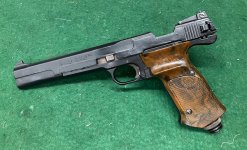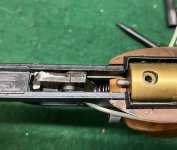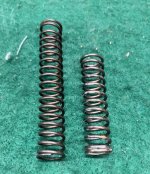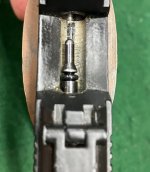I recently picked up a Daisy 790 in pieces and decided to put it back together this afternoon. A previous owner had replaced some of the seals, but left the original exhaust valve and small o-ring in the piercing assembly. Once everything was cleaned, lubricated and all new seals and valve installed, it works just fine. Results from a string across my chrono showed 446 fps average for five shots, with an SD of 2. This muzzle velocity was measured while the pistol was on the lowest adjustable setting, and matches the figures put out by Daisy.

This pistol was made mid 1981. so it's still more S&W than Daisy. That said, there are some Daisy differences I thought I'd point out for others working on these pistols.

Daisy changed out the trigger spring and added a plastic seat (visible under the tip of the exhaust valve. This isn't the drop safe trigger they would eventually changed to, but it does increase pull weight to about 5 lbs.

The hammer spring is quite a bit longer than a typical 78g spring. No doubt this it the main reason for the increase in velocity over a standard 79g. The factory service manual advises that original springs in Smith and earlier daisy pistols should have their hammer spring replaced to the new longer one.

Every 1981 780 and 790 made after the first batch (which were just rebranded Smith pistols) has a loading trough that was reamed oversized. This results in more slop in the bolt which requires more attention while loading than on Smith pistols.

This pistol was made mid 1981. so it's still more S&W than Daisy. That said, there are some Daisy differences I thought I'd point out for others working on these pistols.

Daisy changed out the trigger spring and added a plastic seat (visible under the tip of the exhaust valve. This isn't the drop safe trigger they would eventually changed to, but it does increase pull weight to about 5 lbs.

The hammer spring is quite a bit longer than a typical 78g spring. No doubt this it the main reason for the increase in velocity over a standard 79g. The factory service manual advises that original springs in Smith and earlier daisy pistols should have their hammer spring replaced to the new longer one.

Every 1981 780 and 790 made after the first batch (which were just rebranded Smith pistols) has a loading trough that was reamed oversized. This results in more slop in the bolt which requires more attention while loading than on Smith pistols.